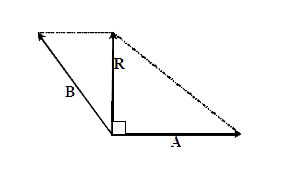The sum of two vectors A and B is at right angles to their difference. Then
a. Equal to each other
b. Equal to each other in a magnitude
c. Not equal to each other in magnitude
d. Cannot be predicted
The correct Answer is:B
To solve the problem, we need to analyze the given information about the vectors A and B.
1. Define the Vectors:
Let vector A and vector B be the two vectors in question.
2. Sum and Difference of Vectors:
- The sum of the vectors is given by:
P=A+B
- The difference of the vectors is given by:
Q=A−B
3. Condition of Perpendicularity:
According to the problem, the sum P is perpendicular to the difference Q. This means:
P⋅Q=0
4. Substituting the Expressions for P and Q:
Substitute P and Q into the dot product:
(A+B)⋅(A−B)=0
5. Expanding the Dot Product:
Using the distributive property of the dot product:
A⋅A−A⋅B+B⋅A−B⋅B=0
Since A⋅B=B⋅A, we can simplify this to:
|A|2−|B|2=0
6. Conclusion:
From the equation |A|2−|B|2=0, we can conclude that:
|A|2=|B|2⟹|A|=|B|
This means that the magnitudes of vectors A and B are equal.
Final Answer:
The correct option is that the magnitudes of vectors A and B are equal.
---
Let vector A and vector B be the two vectors in question.
- The sum of the vectors is given by:
P=A+B
- The difference of the vectors is given by:
Q=A−B
According to the problem, the sum P is perpendicular to the difference Q. This means:
P⋅Q=0
Substitute P and Q into the dot product:
(A+B)⋅(A−B)=0
Using the distributive property of the dot product:
A⋅A−A⋅B+B⋅A−B⋅B=0
Since A⋅B=B⋅A, we can simplify this to:
|A|2−|B|2=0
From the equation |A|2−|B|2=0, we can conclude that:
|A|2=|B|2⟹|A|=|B|
This means that the magnitudes of vectors A and B are equal.
The correct option is that the magnitudes of vectors A and B are equal.
Topper's Solved these Questions
- BOOK - CENGAGE PHYSICS ENGLISHCHAPTER - VECTORSEXERCISE - Exercise Multiple Correct5videos
VECTORS
- BOOK - CENGAGE PHYSICS ENGLISHCHAPTER - VECTORSEXERCISE - Exercise Subjective28videos
VECTORS
- BOOK - CENGAGE PHYSICS ENGLISHCHAPTER - TRAVELLING WAVESEXERCISE - Integer9videos
TRAVELLING WAVES
- BOOK - CENGAGE PHYSICS ENGLISHCHAPTER - WORK, POWER & ENERGYEXERCISE - Archives (integer)4videos
WORK, POWER & ENERGY
Similar Questions
The resultant of two vector A and B is at right angles to A and its magnitude is half of B. Find the angle between A and B.
View SolutionTwo vectors →Aand→B are at right angles to each other then
View SolutionThe magnitude of the sum of two vectors is equal to the difference in their magnitudes. What is the angle between vectors?
View SolutionIf the sum of two unit vectors is a unit vector, then magnitude of difference is-
View SolutionThe sum of two angles of a triangle is 800 and their difference is 200 . Find all the angles.
View SolutionThe sum of two angles of a triangle is 800 and their difference is 200. Find all the angles.
View SolutionThe resultant of two vectors at right angles is 5 N. If the angle between them is 120∘ and the resultant is √13 then the magnitude of vectors are
View SolutionThe resultant of two vectors A and B is perpendicular to the vector A and its magnitude is equal to half the magnitude of vector B. The angle between A and B is -
 View Solution
View SolutionThe maximum and minimum magnitudes of the resultant of two vectors are 23 units and 7 units respectively. If these two vectors are acting at right angles to each other, the magnitude of their resultant will be
View SolutionThe maximum and minimum magnitudes of the resultant of two vectors are 23 units and 7 units respectively. If these two vectors are acting at right angles to each other, the magnitude of their resultant will be
View Solution

